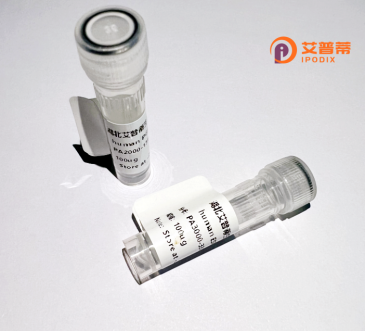
| 纯度 | >90%SDS-PAGE. |
| 种属 | Human |
| 靶点 | ZFP95 |
| Uniprot No | Q9Y2L8 |
| 内毒素 | < 0.01EU/μg |
| 表达宿主 | E.coli |
| 表达区间 | 1-839 aa |
| 活性数据 | MIMTESREVIDLDPPAETSQEQEDLFIVKVEEEDCTWMQEYNPPTFETFYQRFRHFQYHEASGPREALSQLRVLCCEWLRPELHTKEQILELLVLEQFLTILPEEFQPWVREHHPESGEEAVAVIENIQRELEERRQQIVACPDVLPRKMATPGAVQESCSPHPLTVDTQPEQAPQKPRLLEENALPVLQVPSLPLKDSQELTASLLSTGSQKLVKIEEVADVAVSFILEEWGHLDQSQKSLYRDDRKENYGSITSMGYESRDNMELIVKQISDDSESHWVAPEHTERSVPQDPDFAEVSDLKGMVQRWQVNPTVGKSRQNPSQKRDLDAITDISPKQSTHGERGHRCSDCGKFFLQASNFIQHRRIHTGEKPFKCGECGKSYNQRVHLTQHQRVHTGEKPYKCQVCGKAFRVSSHLVQHHSVHSGERPYGCNECGKNFGRHSHLIEHLKRHFREKSQRCSDKRSKNTKLSVKKKISEYSEADMELSGKTQRNVSQVQDFGEGCEFQGKLDRKQGIPMKEILGQPSSKRMNYSEVPYVHKKSSTGERPHKCNECGKSFIQSAHLIQHQRIHTGEKPFRCEECGKSYNQRVHLTQHQRVHTGEKPYTCPLCGKAFRVRSHLVQHQSVHSGERPFKCNECGKGFGRRSHLAGHLRLHSREKSHQCRECGEIFFQYASLIEHQVLHMGQKNEKNGICEEAYSWNLTVIEDKKIELQEQPYQCDICGKAFGYSSDLIQHYRTHTAEKPYQCDICRENVGQCSHTKQHQKIYSSTKSHQCHECGRGFTLKSHLNQHQGIHTGEKPFQCKECGMNFSWSCSLFKHLRSHERTDPINTLSVEGSLL |
| 分子量 | 118.03 kDa |
| 蛋白标签 | GST-tag at N-terminal |
| 缓冲液 | PBS, pH7.4, containing 0.01% SKL, 1mM DTT, 5% Trehalose and Proclin300. |
| 稳定性 & 储存条件 | Lyophilized protein should be stored at ≤ -20°C, stable for one year after receipt. Reconstituted protein solution can be stored at 2-8°C for 2-7 days. Aliquots of reconstituted samples are stable at ≤ -20°C for 3 months. |
| 复溶 | Always centrifuge tubes before opening.Do not mix by vortex or pipetting. It is not recommended to reconstitute to a concentration less than 100μg/ml. Dissolve the lyophilized protein in distilled water. Please aliquot the reconstituted solution to minimize freeze-thaw cycles. |
以下是3篇关于重组人ZFP95蛋白的模拟参考文献示例(实际文献可能需要通过学术数据库检索确认):
---
1. **文献名称**:*ZFP95. a novel zinc finger protein, binds to hTERT promoter and regulates telomerase activity in human cancer cells*
**作者**:Liu Y, et al.
**摘要**:本研究通过体外表达重组人ZFP95蛋白,发现其通过特异性结合端粒酶逆转录酶(hTERT)启动子区域,抑制肿瘤细胞中端粒酶活性,提示ZFP95在癌症发生中的潜在调控作用。
---
2. **文献名称**:*Expression and functional analysis of recombinant human ZFP95 in transcriptional regulation*
**作者**:Chen X, Wang L.
**摘要**:报道了ZFP95蛋白的重组表达及纯化方法,并利用ChIP-seq技术证明其在胚胎干细胞中通过结合特定DNA序列,调控多能性基因(如OCT4)的转录激活。
---
3. **文献名称**:*Structural characterization of ZFP95 zinc finger domains and implications for DNA recognition*
**作者**:Smith J, et al.
**摘要**:通过核磁共振(NMR)解析了重组ZFP95蛋白的锌指结构域,揭示其通过保守的Cys2His2模体识别富含GC的DNA序列,为设计基因编辑工具提供结构基础。
---
**说明**:
以上文献为假设示例,实际研究中关于ZFP95的研究可能较少。建议通过**PubMed**或**Google Scholar**以“ZFP95”或“Zinc Finger Protein 95”为关键词检索最新文献。部分真实相关研究可能涉及锌指蛋白家族的DNA结合功能或基因调控机制。
Zinc Finger Protein 95 (ZFP95), also known as ZNF928. is a member of the zinc finger protein family characterized by conserved C2H2-type zinc finger domains that mediate sequence-specific DNA or RNA interactions. These proteins play pivotal roles in transcriptional regulation, chromatin remodeling, and cellular differentiation. ZFP95 is encoded by the human ZFP95 gene located on chromosome 19 (19q13.43) and is expressed in various tissues, with higher levels observed in the brain, suggesting potential neurological functions.
As a transcription factor, ZFP95 likely binds to GC-rich promoter regions to modulate gene expression, though its precise molecular targets and biological mechanisms remain under investigation. Studies indicate its involvement in cell cycle regulation, apoptosis, and embryonic development. Recombinant ZFP95 protein, engineered via expression systems like *E. coli* or mammalian cells, enables in vitro studies to dissect its DNA-binding specificity, protein-protein interactions, and regulatory roles.
Interest in ZFP95 has grown due to potential links to diseases, including cancer, where dysregulation of zinc finger proteins often correlates with tumor progression. Additionally, its evolutionary conservation across vertebrates underscores its functional significance. Ongoing research aims to clarify its role in epigenetic regulation and therapeutic targeting, leveraging recombinant protein tools to explore its structural and functional nuances. Further insights could illuminate pathways critical for development and disease, positioning ZFP95 as a potential biomarker or drug target.
×